Omkareshwara temple
Omkareshwar Mandir: A Spiritual Center alongside Narmada
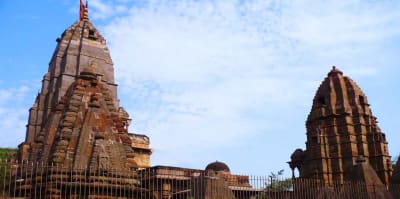
Shaped like the holy symbol "Om," Omkareshwar Temple is situated alongside the waters of the Narmada River. It is a revered Hindu pilgrimage site in Madhya Pradesh, India. Dedicated to Lord Shiva, Omkareshwar Temple holds immense significance for devotees and boasts a rich history intertwined with spirituality and stunning architecture.
History of Omkareshwar Temple
According to ancient Hindu scriptures, Omkareshwar Temple is believed to be one of the holiest places on earth. The legend recounts that once, the Devas (celestial beings) and the Asuras (demons) were engaged in a fierce battle for control of the universe. During this cosmic struggle, drops of the nectar of immortality (Amrita) fell on earth from a kumbh (pot) carried by Garuda, the divine bird.
These drops of Amrita fell at various places across India, creating sacred sites known as Jyotirlingas, manifestations of Lord Shiva's cosmic energy. Omkareshwar Temple is said to be the abode of one such Jyotirlinga, where Lord Shiva manifested himself as Omkareshwar, the Supreme Being.
The historical records of Omkareshwar Temple trace its existence to ancient times. The temple's architecture reflects a blend of different periods, with elements ranging from the medieval to the modern era. Over the centuries, various rulers and dynasties contributed to the temple's construction and restoration, leaving behind a legacy of cultural and architectural richness.
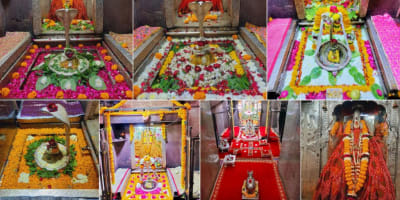
During the medieval period, the temple witnessed phases of prosperity and challenges. It received patronage from rulers like the Chalukyas, the Paramaras, and the Marathas, who contributed to its expansion and embellishment. However, the temple also faced periods of destruction and invasions, notably during the reign of Mughal emperors.
One of the significant historical events associated with Omkareshwar Temple is its restoration by the Holkar dynasty in the 18th century. Rani Ahilyabai Holkar, the benevolent ruler of Indore, undertook extensive renovations of the temple complex, rejuvenating its grandeur and ensuring its continuity as a place of worship and pilgrimage.
Today, Omkareshwar Temple stands as a testament to India's ancient traditions, enduring faith, and architectural prowess. It continues to draw millions of devotees and tourists who seek blessings, spiritual solace, and a glimpse into the rich cultural heritage of India. The history of Omkareshwar Temple is not just a chronicle of the past but a living legacy that resonates with the present, carrying forward the essence of devotion and reverence for Lord Shiva.
Significance of the Temple
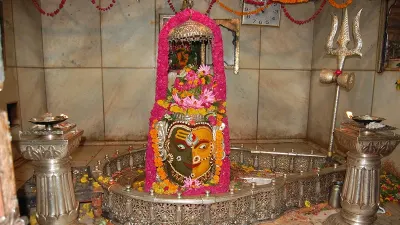
Omkareshwar Temple holds great significance for Hindus for a multitude of reasons. First and foremost, it's a revered abode of Lord Shiva, one of the principal deities in Hinduism. Devotees believe that a visit (darshan) here brings blessings, removes obstacles, and fulfills wishes. Many Hindus consider visiting Omkareshwar, especially during auspicious occasions, to be a pilgrimage of great importance.
Omkareshwar has the unique distinction of housing not one, but two Jyotirlingas – the holiest abodes of Lord Shiva. Imagine two powerful manifestations of Shiva residing in one sacred location! The Omkareshwar Jyotirlinga enshrines the 'Omkaara' aspect of Shiva, symbolizing the all-encompassing nature of the divine. Meanwhile, the Mamleshwar Jyotirlinga, situated on the opposite bank of the Narmada River, represents the 'Ardha' (half) aspect of Shiva. This duality adds immense spiritual power to the temple, allowing devotees to seek blessings from both complete and partial manifestations of Lord Shiva.
But the significance goes beyond the deities. The very location of the temple adds another layer of importance. Omkareshwar rests on Mandhata Island, shaped remarkably like the holy "Om" symbol. Devotees consider the entire island to be sacred ground. The belief is that a dip in the holy Narmada River encircling the island further purifies their souls. So, a pilgrimage to Omkareshwar nourishes both the spirit through seeking blessings and the body through a dip in the sacred waters.
Architecture of Omkareshwar Temple
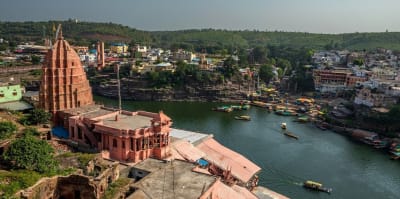
The temple has a unique blend of North and South Indian architectural styles. The centerpiece of the complex is the main Omkareshwar Temple. Its towering shikhara, the spire that dominates the skyline, is a sight to behold. Imagine a majestic cone-shaped structure, crafted from intricately carved sandstone. The carvings on the shikhara depict scenes from Hindu tradition, showcasing the immense skill of the builders. As you approach the sanctum sanctorum, the inner sanctum where the holy lingam resides, you'll pass through a grand entrance called the Gopuram. This gateway boasts a completely different architectural style. Unlike the shikhara's intricate carvings, the Gopuram features vibrant colors and a distinctive Dravidian architectural style, transporting you to a realm steeped in South Indian tradition.
The beauty doesn't stop there. The temple complex houses numerous shrines, each dedicated to different aspects of Lord Shiva. These shrines boast unique architectural features, offering a glimpse into the artistic diversity that flourished when the temple was built. The main sanctum sanctorum itself is a marvel. Here, you'll find the revered Omkareshwar Lingam, a self-manifested form of Shiva, enshrined within.
Moving beyond the individual structures, the entire temple complex is designed to enhance the spiritual experience. Steps leading down to the Narmada River, considered holy by Hindus, allow devotees to perform sacred rituals and take a dip in the holy waters. The serene Narmada River flowing by the temple complex adds a touch of tranquility to the overall atmosphere. Imagine the gentle sounds of the flowing water blending with the chants of devotees, creating a truly calming and spiritually uplifting environment.
Temple Timings and Other Details
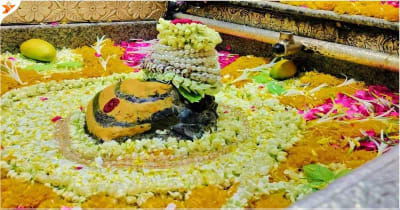
Timings:
- 04:30 AM to 05:00 AM - Mangla Aarti and Naivedhya
- 05:00 AM to 12:20 PM - Mangal Darshan of Lord
- 12:20 PM to 01:15 PM - Midday Bhog
- 01:15 PM to 04:00 PM - Midday Darshan of Lord
- 04:00 PM to 04:15 PM - Evening Shringar
- 04:15 PM to 08:00 PM - Shringar Darshan of Lord
- 08:30 PM to 09:00 PM - Shayan Shringar and Aarti
- 09:00 PM to 09:30 PM - Lord's Shayan Shringar Darshan
Official Website of the Temple: https://shriomkareshwar.org/
Photography Restrictions: Photography is not permitted inside the sanctum sanctorum. However, you can capture stunning photos of the temple's exterior, including the ornately carved gopuram, the majestic shikhara, and the serene Narmada River flowing by.
Location of the Temple
Omkareshwar is located in the Khandwa district of Madhya Pradesh, India. It is situated on an island called Mandhata or Shivapuri in the Narmada River. The island is about 1 kilometer long and half a kilometer wide and is connected to the mainland by a bridge. Omkareshwar is approximately 77 kilometers away from the city of Indore, which is a major transportation hub in the region. The scenic beauty of Omkareshwar, surrounded by the flowing Narmada River and lush greenery, adds to its spiritual charm and makes it a popular pilgrimage destination.
Google Maps Location: Click Here
Nearby Tourist Attractions
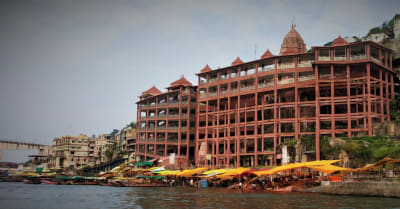
Your Omkareshwar experience needn't be limited to the temple itself. Here are some captivating nearby attractions you can explore:
- Shri Siddheshwar Temple: Dedicated to Lord Ganesha, this temple is believed to be an auspicious starting point for a pilgrimage in Omkareshwar.
- Shri Gauri Somnath Temple: This ancient temple, dedicated to Lord Shiva and Parvati, offers a glimpse into the rich history of the region.
- Ahilya Fort: Located on an island facing Omkareshwar, this 18th-century fort built by Queen Ahilyabai Holkar offers beautiful views of the Narmada River.
A Spiritual Escape and Cultural Immersion
Omkareshwar is more than just a temple; it's a spiritual oasis where faith and tranquility converge. A visit allows you to experience the rich culture of Hinduism, marvel at architectural wonders, and embark on a journey of inner peace. So, plan your trip, embrace the experience with an open mind, and discover the magic of Omkareshwar, a place where the holy "Om" symbol comes alive.




